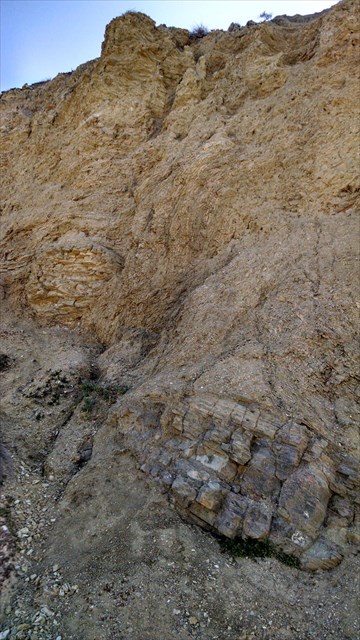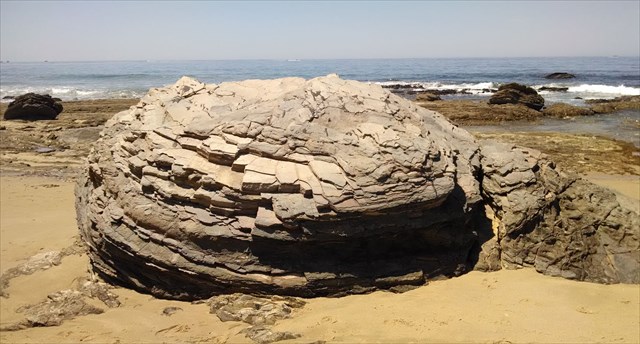Getting Started
This EarthCache is located along the beach in Crystal Cove State Park. The closest parking is in the Los Trancos Area parking lot. From PCH, turn at the intersection with Los Trancos (see Additional Waypoints below). There is a day use fee for parking. At the time of cache publication, it was $15. But you can easily spend the whole day exploring the beach and backcountry of this park. You can also use your receipt for this park to gain free access to any other state parks on the same day.
From the parking lot, take the walkway that begins in the southeast corner. Follow it down through the tunnel under PCH towards the beach. Then walk south through the Crystal Cove Historic District and onto the beach. You may want to make this an EarthCaching two-fer, by pairing it with “Crystal Cove - A Gap In Time” (GC543MV).
Concretions
|
So, what are concretions and how are they formed?
A concretion is a hard, compact mass of sedimentary rock which is formed by the precipitation of mineral cement within the spaces between the sediment grains. This precipitation is typically caused by a foreign nucleus, often organic, such as a leaf, tooth, piece of shell or fossil. It is thought that the nuclei for the concretions along this stretch of beach are generally pieces of wood - bark, branches and roots. Concretions form within layers of sedimentary strata that have already been deposited. They usually form early in the burial history of the sediment, before the rest of the sediment has hardened into rock. The concretionary cement often makes the concretion harder and more resistant to weathering than the host stratum.
Concretions vary in shape, hardness and size. They range from sizes that require a magnifying lens to be clearly visible, to huge bodies three meters or more in diameter and weighing several thousand pounds. Because of the variety of unusual shapes, sizes and compositions, concretions have been interpreted to be dinosaur eggs, animal and plant fossils (called “pseudofossils”), extraterrestrial debris, and human artifacts. Some of the most unusual concretion nuclei are World War II military shells, bombs, and shrapnel, which are found inside siderite concretions in an English coastal salt marsh.
|
 |

Logging Requirements
At this particular location, you can see concretions both in the outcropping along the shoreline as well as embedded in the cliffside. Please make careful observations of both.
Send me a note with:
- The text “Crystal Cove - Giant Concretions (GC543MM)” on the first line.
- The names of all the geocachers in your group for whom you are submitting answers.
- In the outcropping along the shoreline, how many large concretions do you see?
- What is the shape and approximate size of the largest one?
- Embedded in the cliffside, how many large concretions do you see? Look carefully because some have colors which contrast with the material in the cliff face, while others do not.
- What are the colors, shapes, and range of approximate sizes in the cliffside concretions?
- Extra Credit: If you have the time and interest, continue south to the secondary coordinates (see Additional Waypoints below) at the southern end of this concretion-rich section of the beach. Along the way you can find many more stunning examples of giant concretions. Post photos and coordinates of your favorites. But please don’t post any spoiler photos of the specific concretions at the primary coordinates which are the subjects for the logging questions.
Please submit your answers when you log this cache. You do not have to wait for confirmation before logging. Logs for which answers are not submitted will be deleted.
Please don’t include the answers to any questions in your log, even if encrypted!
The following sources were used to create this EarthCache:



